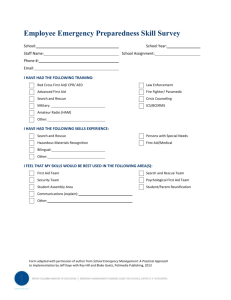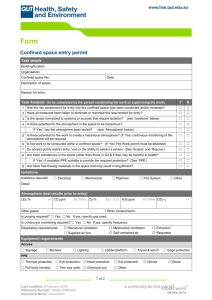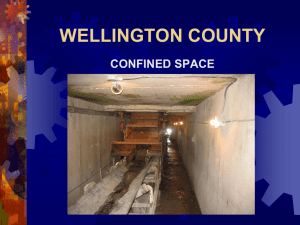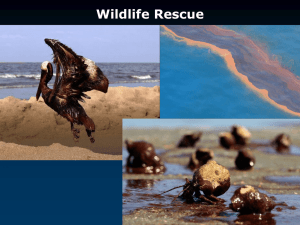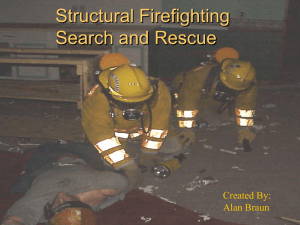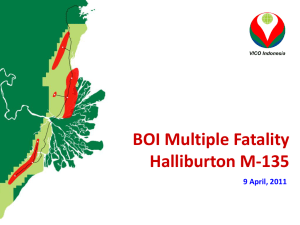ZONE 3 CONFINED SPACE RESCUE
advertisement
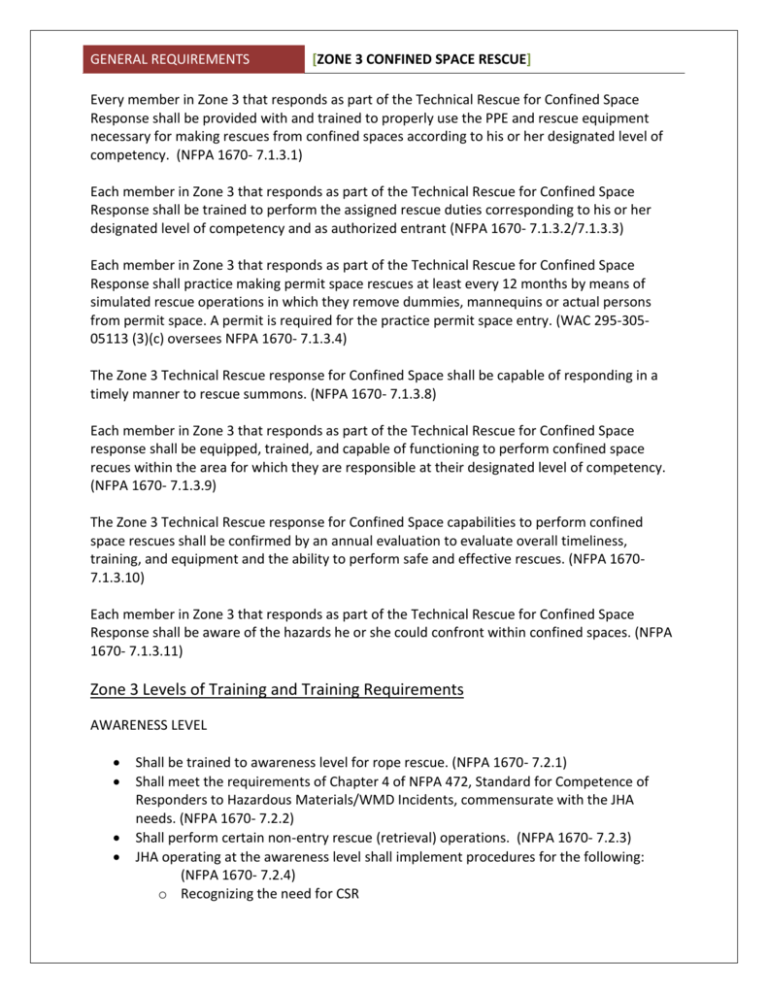
GENERAL REQUIREMENTS [ZONE 3 CONFINED SPACE RESCUE] Every member in Zone 3 that responds as part of the Technical Rescue for Confined Space Response shall be provided with and trained to properly use the PPE and rescue equipment necessary for making rescues from confined spaces according to his or her designated level of competency. (NFPA 1670- 7.1.3.1) Each member in Zone 3 that responds as part of the Technical Rescue for Confined Space Response shall be trained to perform the assigned rescue duties corresponding to his or her designated level of competency and as authorized entrant (NFPA 1670- 7.1.3.2/7.1.3.3) Each member in Zone 3 that responds as part of the Technical Rescue for Confined Space Response shall practice making permit space rescues at least every 12 months by means of simulated rescue operations in which they remove dummies, mannequins or actual persons from permit space. A permit is required for the practice permit space entry. (WAC 295-30505113 (3)(c) oversees NFPA 1670- 7.1.3.4) The Zone 3 Technical Rescue response for Confined Space shall be capable of responding in a timely manner to rescue summons. (NFPA 1670- 7.1.3.8) Each member in Zone 3 that responds as part of the Technical Rescue for Confined Space response shall be equipped, trained, and capable of functioning to perform confined space recues within the area for which they are responsible at their designated level of competency. (NFPA 1670- 7.1.3.9) The Zone 3 Technical Rescue response for Confined Space capabilities to perform confined space rescues shall be confirmed by an annual evaluation to evaluate overall timeliness, training, and equipment and the ability to perform safe and effective rescues. (NFPA 16707.1.3.10) Each member in Zone 3 that responds as part of the Technical Rescue for Confined Space Response shall be aware of the hazards he or she could confront within confined spaces. (NFPA 1670- 7.1.3.11) Zone 3 Levels of Training and Training Requirements AWARENESS LEVEL Shall be trained to awareness level for rope rescue. (NFPA 1670- 7.2.1) Shall meet the requirements of Chapter 4 of NFPA 472, Standard for Competence of Responders to Hazardous Materials/WMD Incidents, commensurate with the JHA needs. (NFPA 1670- 7.2.2) Shall perform certain non-entry rescue (retrieval) operations. (NFPA 1670- 7.2.3) JHA operating at the awareness level shall implement procedures for the following: (NFPA 1670- 7.2.4) o Recognizing the need for CSR GENERAL REQUIREMENTS [ZONE 3 CONFINED SPACE RESCUE] o Initiating contact and establishing communications with victims where possible o Recognizing and identifying the hazards associated with non-entry confined space emergencies o Recognizing confined spaces o Performing a non-entry retrieval o Implementing the emergency response system for CSR emergencies o Implementing site control and scene management o Implementing site control and scene management OPERATIONS LEVEL NFPA 1670- 7.1.4 requires operational teams to operate with a minimum of 4 personnel. Shall meet the requirements of Awareness level CSR. (NFPA 1670- 7.3.1) Shall meet the requirements of operations level for rope rescue. (NFPA 1670- 7.3.1) Shall meet the General Requirements listed above. (NFPA 1670- 7.1.3) Zone 3 departments operating at the operations level shall develop and implement procedures for the following: (NFPA 1670- 7.3.3) o Sizing up existing and potential conditions at CSRs o Protecting personnel from hazards within the confined space o Ensuring that personnel are capable of managing the physical and psychological challenges that affect rescuers entering confined spaces o Identifying the duties of the rescue entrants, backup rescue entrants, rescue attendant, and rescue team leader o Monitoring continuously, or at frequent intervals, the atmosphere in all parts of the space for O2, flammability, and toxicity, in that order o Can perform entry-type rescues into confined spaces meeting all of the following specific qualifying characteristics: The internal configuration of the space is clear and unobstructed so retrieval systems can be utilized for rescuers without possibility of entanglement. The victim can be easily seen from the outside of the space's primary access opening. Rescuers can pass easily through the access/egress opening(s) with room to spare when PPE is worn in the manner recommended by the manufacturer. The space can accommodate two or more rescuers in addition to the victim. All hazards in and around the confined space have been identified, isolated, and controlled. Using victim packaging devices that could be employed in confined space rescue Selecting, constructing, and using a rope-lowering and-raising system in the high-angle environment GENERAL REQUIREMENTS [ZONE 3 CONFINED SPACE RESCUE] TECHNICIAN LEVEL NFPA 1670- 7.1.4 requires CSR tech teams to operate with a minimum of 6 personnel. Shall meet all requirements listed above. (NFPA 1670- 7.4.1) Shall meet the awareness level for machinery search and rescue. (NFPA 1670- 7.4.1) Zone 3 departments operating at the technician level for CSR shall develop and implement procedures for the following: (NFPA 1670- 7.4.3) a. Developing hazard isolation and control requirements. b. Ensuring that rescue team members take part in a medical surveillance program c. Planning response for entry-type CSR in hazardous environments d. Implementing the planned response WAC 296-305-05113 – CONFINED SPACE RESCUE OPERATIONS Fire departments which will respond to calls to perform rescue from a permit-required confined space are required to have each member of a rescue team practice making permit space rescues at least every 12 months by means of simulated rescue operations in which they remove dummies, mannequins or actual persons from permit space. A permit is required for the practice permit space entry. During an actual rescue response, written or verbally recorded hazard sizeup will be allowed in lieu of the written permit requirements in WAC 296-809-50004 and shall be completed prior to any entry. This sizeup shall include at a minimum: o Recognition and declaration of the situation as a confined space incident. o Denial of entry to unprotected persons. o Assessment of all readily available confined space documentation, e.g., MSDSs, any existing permit, plans or blueprints of the space. o Assessment of number of victim(s), locations and injury conditions. o Discussion with witnesses, supervisor and other sources of information. o Assessment of any current or potential space hazards, in particular, any hazard(s) which lead to the necessary rescue. o Determination and declaration if body recovery or victim rescue. At confined space incidents, at least two people outside shall be equipped with appropriate breathing apparatus to act as the back-up team, which shall remain free of the contaminated area in order to rescue disabled firefighters. Written documentation of the rescue team's training on the fire department's confined space operating procedures, authorized entrant training, and the contracted host's confined space program shall be kept. A record of each of the hazard sizeups shall be maintained for at least one year.
